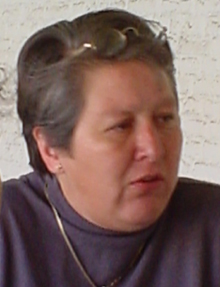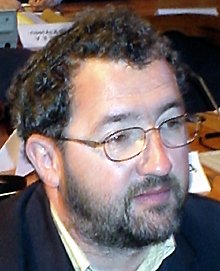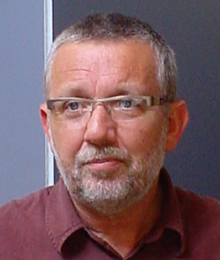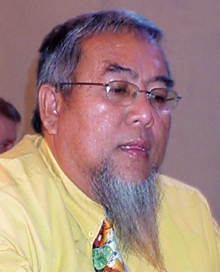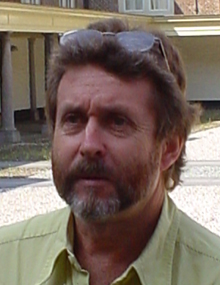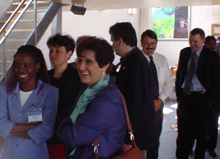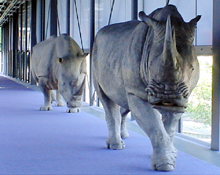|
 |
|
Aquilaria spp.: On Thursday, 16 May, Barbara Gravendeel, Leiden University, presented on a CITES-funded study conducted to develop species-specific DNA markers in Aquilaria (PC12/Inf. 1). Describing the basic characteristics of the 15 Aquilaria species, she explained that the wood can be infected by a fungus that produces a resin (gaharu) used in rituals, medicines and perfume. She said gaharu is highly priced and global demand is higher than available supply. She noted that because gaharu-containing wood is usually traded as dry samples, it cannot be identified at the species level. She stated that there are few species- and region-specific mutations in Aquilaria, and that further work is necessary to isolate DNA in wood samples and to develop an easy-to-apply test for customs officials.
 Listen
to Barbara Gravendeel's presentation Listen
to Barbara Gravendeel's presentation
In the subsequent discussion, Europe asked the time required to develop the test. Gravendeel responded that six months are needed if fresh samples are available, although there are difficulties when working with old or contaminated wood. Mexico enquired about identification of species based on gaharu's phytochemical characteristics. Oceania asked if there is trade information on other gaharu-producing genera.
 Listen
to agarwood discussion Listen
to agarwood discussion
TRAFFIC introduced an information document on agarwood (PC12/Doc. 8.3), noting the increasing importance of DNA testing in distinguishing species. He identified several recommendations, including, inter alia, the need for ground-truthing of populations in agarwood harvesting areas, and further field research on gaharu trade dynamics. Oceania emphasized the need for a reporting mechanism and links with traders to understand the total trade in agarwood. He added that Aquilaria could be a good candidate for the significant trade review process. The Secretariat said the main advantage of an Appendix III listing is that the countries of export and import may eliminate the illegal trade. Central and South America and the Caribbean called for further taxonomic efforts to assess the species. The Committee agreed to support the recommendations made by TRAFFIC, and the Chair will include the comments in her report to COP-12.
 Listen
to the TRAFFIC presentation Listen
to the TRAFFIC presentation
 Listen
to a discussion on the presentation Listen
to a discussion on the presentation
ISSUES RESULTING FROM PC-11: This agenda item was discussed on
Thursday, 16 May.
Review on the genus Taxus: The US presented the review
of the genus Taxus (PC12/Doc. 20.1), noting that the Plants Committee
should examine the trade in all Taxus species to determine if
additional species should be included in an Appendix listing. Italy
added a document on its review on the genus Taxus (PC12/Doc.
20.1.1), supporting a CITES listing. China also supported an Appendix
II listing, adding that chemical derivatives would have to be addressed
as the main problem of Taxus trade. Hungary, with Switzerland,
the Czech Republic and Poland, raised concerns about listing the whole
Taxus genus, noting technical difficulties in countries where
particular species, such as Taxus baccata, was common and not
threatened. She added that protection could be solved through national
legislation. Chair Clemente recommended that the US continue reviewing
this issue and consider the comments made by the range States before
proposing a listing.
Illegal trade in Paphiopedilum spp.: The US noted a document
submitted at PC-11 regarding the problems associated with the illegal
trade in Paphiopedilum. He said that the US seized a number of
these plants and was considering releasing them into the market to suppress
the demand for illegal products. He added that there are commercial
propagators in the US who would be willing to assist in reintroducing
plants into the wild. The Secretariat said that the issue could be further
discussed at the next Plants Committee meeting.
Relationship between ex situ production and in situ conservation:
The Secretariat introduced the topic (PC12/Doc. 20.3). He said the Animals
Committee had requested the Secretariat to re-issue their request for
information on the issue of ex situ production and in situ
conservation, asking for positive examples. The Secretariat intends
to re-submit the notification to Parties, also seeking flora examples.
The Chair, with Mexico, Austria, the US, and Africa, on behalf of the
Cycad Specialist Group (CSG), supported including a request for plant
examples. The IUCN highlighted their recent workshop on related issues
(PC12/Doc. 20.3 Annex 2).
 Listen
to Mexico discuss the issue
Listen
to Mexico discuss the issue
 Listen
to the Secretariat's comments
Listen
to the Secretariat's comments
REVIEW OF THE APPENDICES: This item was discussed on Thursday,
16 May. Africa announced that southern African countries have been reviewing
various Aloe species on the Appendices, and that South Africa
will submit a proposal before COP-12 to downlist Aloe thorncroftii
from Appendix I to II. He added that Lesotho plans to eventually
submit a proposal to downlist Aloe polyphylla. Switzerland described
problems with tracking Appendix I-listed Saussurea costus due
to repeated transfers between Switzerland and Germany for processing
purposes. Germany pointed out that China is the biggest exporter of
Saussurea costus, although the range States are India and Pakistan.
India said it would prepare a document on this issue if required. The
US highlighted potential proposals for consideration at COP-12, such
as downlisting Dudleya traskiaei from Appendix I to Appendix
II.
SIGNIFICANT TRADE IN PLANTS:
Selection of taxa for review: On Thursday, 16 May, the Chair
of the working group on selection of species for the significant trade
review process reported on their work Tuesday evening, 14 May. In an
effort to keep the list for review short, the group decided on the following
species: Prunus africana, Aquilaria, Pericopsis alata,
and Aloe from eastern Africa. Chair Clemente asked for details
regarding how much time and funding the review of these species would
require.
CHECKLISTS AND NOMENCLATURE:
Progress report: On Thursday, 16 May, the Vice-Chair of the nomenclature
committee gave a status report (PC12/Doc. 14.1) of their work, including
the production of several checklists. He added that there were future
plans to work with UNEP-WCMC on orchids, and asked for input from range
States. Austria reported on completion of efforts to collect data for
a Bulbophyllum database, and Switzerland and Mexico reported
on publications on cacti nomenclature. Austria and Germany supported
updating the Euphorbia checklist as a priority task
.
Updated taxonomical list of Opuntia and segregates: Mexico
presented their updated taxonomical list (PC12/Doc. 14.2). The UK urged
Mexico to submit the list for publication before forwarding it to the
COP.
List of the American Dicksonia species: Germany presented
on a list identifying the American Dicksonia species (PC12/Doc.
14.2). Since the list will be used by enforcement authorities, Oceania
requested that species distributions be listed at the country, not sub-regional
or geographical, level.
Identification of Appendix I cacti: On Thursday, 16 May, Switzerland
presented on an identification manual of Appendix I cacti. Noting that
the project took almost three years to complete, he gave a demonstration
of the CD-ROM manual. He said that the manual is currently available
in English, but will be translated to French and Spanish, and that it
has been shipped to the CITES Secretariat for distribution to all Management
and Scientific Authorities.
TRANSPORT OF LIVE PLANTS: On Thursday, 16 May, North America
presented the guidelines for transport of live plants (PC12/Doc. 17),
stating that consultations were conducted with the Chair of the Animals
Committee transport working group. He suggested that: CITES cooperate
with the International Air Transport Association (IATA) to incorporate
aspects of IATA transport policy; the Plants Committee use the IATA
brochure on handling of perishable goods to produce its own, general
information material on all forms of transport; and this information
be made available to border control personnel.
 Listen
to the presentation
Listen
to the presentation
EVALUATION OF CERTIFICATION SCHEMES: On Thursday, 16 May, the
Secretariat introduced a proposal (PC12/Doc. 19) from TRAFFIC regarding
evaluation of certification schemes in forestry and their compatibility
with the scientific requirements of making a non-detriment finding.
He said the evaluation would be funded by the remaining US$10,000 provided
by the US three years ago for Plants Committee projects. The US, with
Malaysia and Asia, opposed the proposal, stating that such a study would
be premature since only a small proportion of traded timber is covered
by certification schemes. The UK suggested that the money be used for
significant trade reviews, while Austria pointed out that the CBD has
a process underway to address forest certification schemes. Europe said
that investigating certification schemes might clarify whether they
can be helpful in making non-detriment findings. North America suggested
that the evaluation be postponed. IWMC-CH warned that this issue could
be very divisive if raised at COP-12. The Committee agreed that the
proposal would not be supported, and that the remaining money would
be used for significant trade reviews.
 Listen
to the intervention by Malaysia
Listen
to the intervention by Malaysia
TIME AND VENUE OF THE 13TH PLANTS COMMITTEE MEETING: The Chair
indicated that Namibia, South Africa and Botswana will be approached
as potential hosts of PC-13, which may be held in August 2003.
CLOSING REMARKS: On behalf of the Committee, Africa notified
delegates that this was the last meeting at which Ger van Vliet would
be attending as CITES Senior Scientific Officer (Flora), and wished
him well in his new post as Senior Capacity Building Officer (Training).
Chair Clemente echoed Africa's words, adding that collaboration with
van Vliet would continue in future meetings. She thanked participants
for their contributions, and the Netherlands for hosting the meeting.
The meeting came to a close at 7:30 pm, a day earlier than scheduled.
|
|









